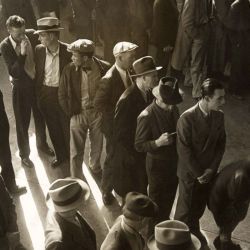
Harry Hopkins, (1890-1946)
Hopkins oversaw the New Deal relief programs. Courtesy, National Archives and Records Administration (NARA).
Harry Lloyd Hopkins (1890-1946) stood at the side of President Franklin Roosevelt through the two terrible crises of the 20th century—the Great Depression and the Second World War. Hopkins was the president’s trusted advisor, his close friend, his gatekeeper, and for three and a half years, his house guest. He was never elected to any office, yet he occupied a position of power in Washington that has yet to be matched.
Hopkins served as FDR’s federal relief administrator from 1933 to 1939, first as supervisor of the Federal Emergency Relief Administration (FERA); then heading the Civil Works Administration (CWA), which put four million unemployed people to work in four months, and later the Works Progress Administration (WPA),

FERA Vocational training camp for unemployed women in Pennsylvania, 1934
Hopkins supervised the first emergency relief effort, FERA, superseded by the CWA and later, the WPA. Courtesy, Library of Congress.
which created jobs for 8.5 million Americans, and left a legacy on the American landscape that endures to this day.
He also served as Secretary of Commerce from 1938 to 1940. Hopkins’ upbringing in America’s heartland and his education at Iowa’s Grinnell College prepared him for his lifelong fight for social justice. As a social worker, his goal was social justice for all Americans. He began his public career with a deeply embedded belief that the government on all levels—but especially the federal government— has the constitutional responsibility to ensure the general welfare of all of its citizens.
He firmly believed that this included the right to earn a decent living and, if private industry could not absorb all those who wanted to work, it rested with the federal government to be the employer of last resort.

Wife and children of a sharecropper, 1936
Hopkins believed government must insure the well-being of all its citizens. Courtesy, National Archives and Records Administration (NARA).
During the dark years of the Depression, Hopkins stood out as the one who knew how to cut through red tape. He had the administrative skills to get things done and a sharp tongue for those who criticized the unemployed as lazy.
During the war years Hopkins deftly carried out power diplomacy, acting as the lynchpin for the Big Three—Roosevelt, Churchill, and Stalin—fighting a coalition war. As Roosevelt’s envoy, he was constantly ill, often to the point of debilitation, but relentlessly served the president’s mission to defeat fascism. For Hopkins, this was the goal of social justice writ large.
For all his adult life, Hopkins worked as a public servant. Human welfare was always his priority – for the welfare Americans suffering deprivation during the economic depression of the 1930s and then from 1940 through 1945, for people worldwide being terrorized by expansionist and militaristic dictators.
At Hopkins memorial service in 1946, John Steinbeck described Hopkins’ legacy: “Human welfare is the first and final task of government. There is no other.”
That dictum—the Americans have the right to live in security and that government has the responsibility to provide for that security— is Hopkins greatest legacy. In the aftermath of Roosevelt’s administrations, Steinbeck wrote, the federal government can no longer deny its responsibility for human welfare.
Today, my grandfather’s legacy remains largely unrecognized. It would serve the nation well to remember that the task of government is to insure the general welfare of all Americans in peace and in war. Those who have the honor to serve in government must understand that this is their first and final responsibility.
Learn more about Harry Hopkins on the Living New Deal’s website.











